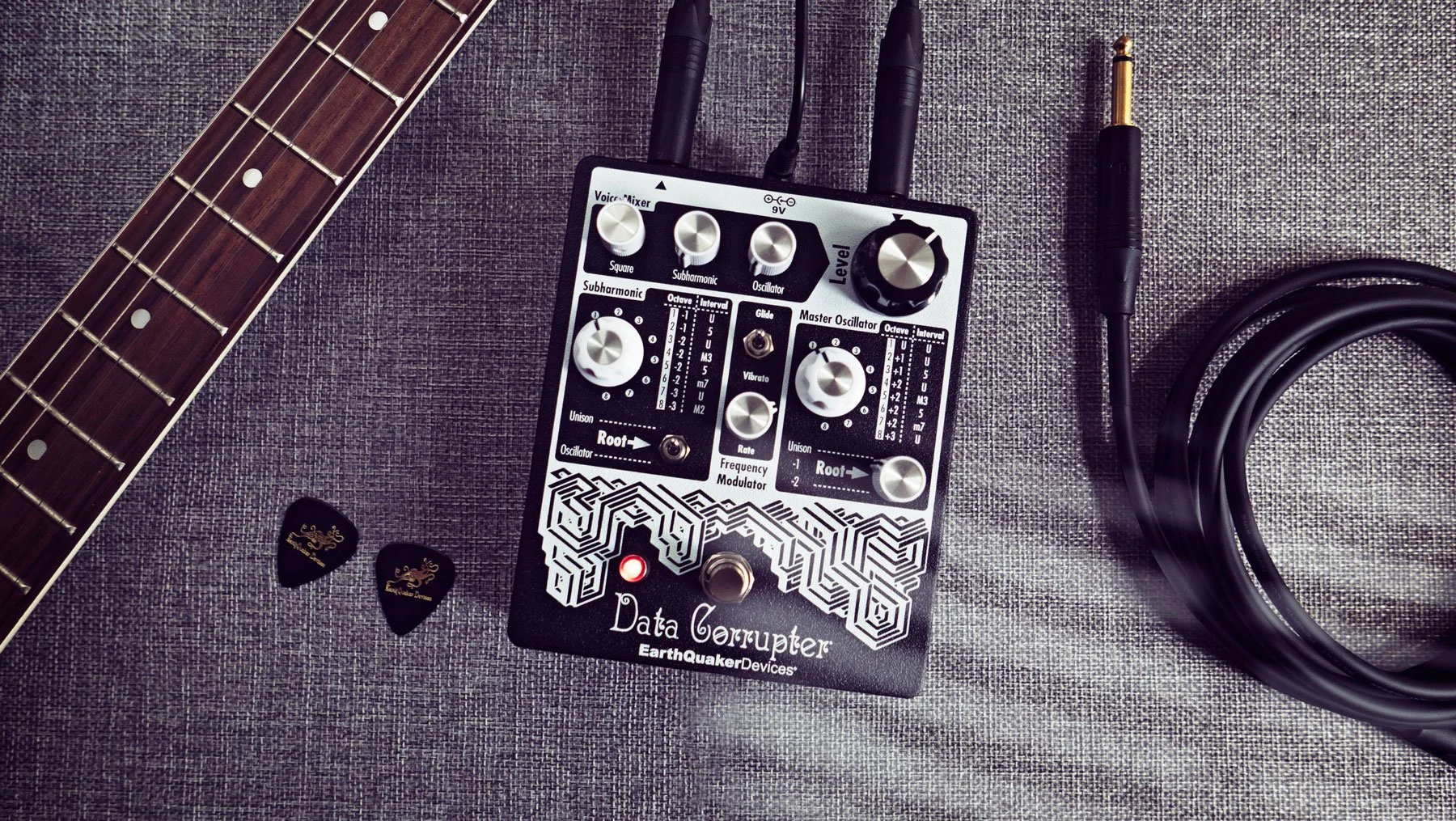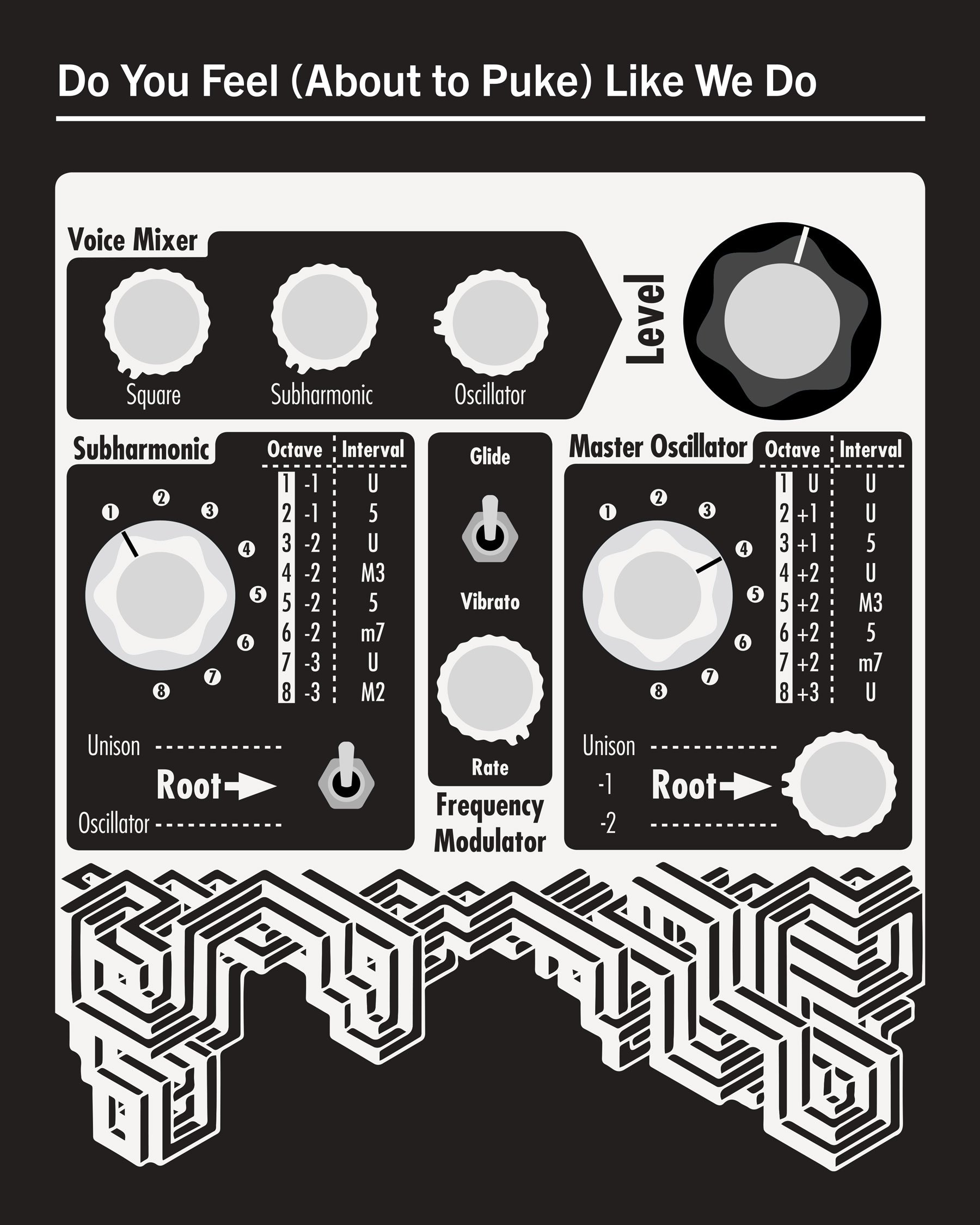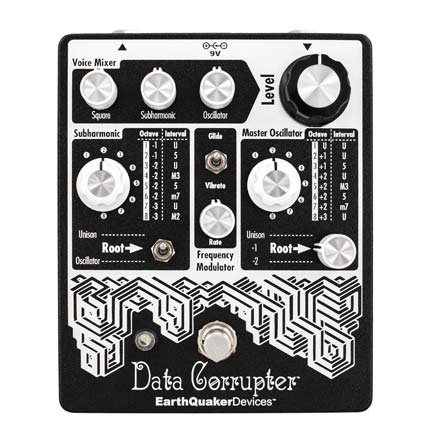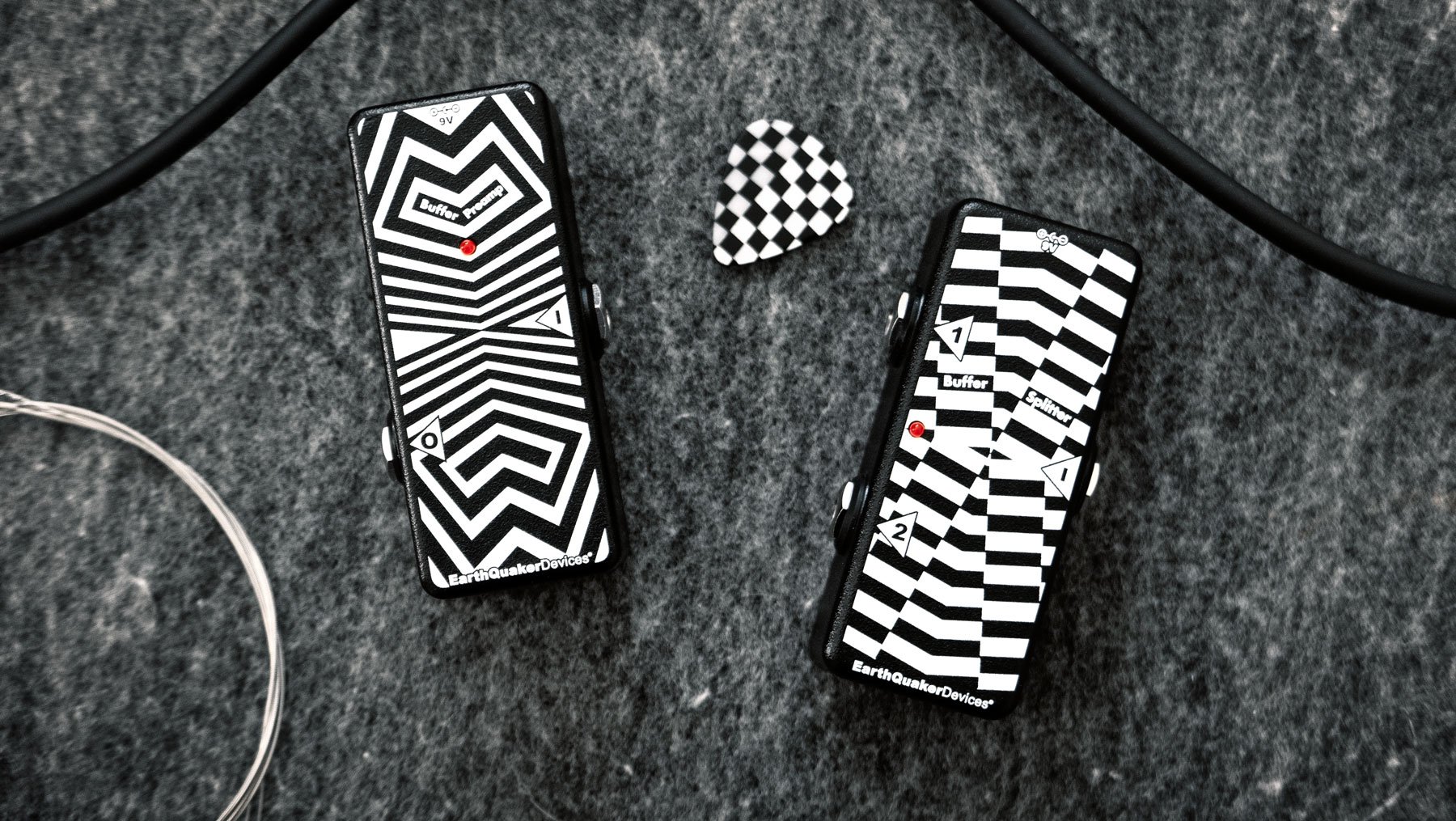6 Super-Usable Data Corrupter Settings
Dan Epstein
The EarthQuaker Devices Data Corrupter could also easily be called the “Lease Breaker,” “Pet Frightener” or “Relationship Killer” — such is its awesome power to unleash patience-testing bursts of brain-melting sounds. If sonic terrorism is your thing, it’s pretty hard to beat this monophonic modulating harmonizing phase-locked looping pedal, which takes your guitar (or bass, or keyboard, or drum machine) signal and turns it into an analog synthesized frequency, which can then be harmonized, bent, warped and splattered in an impressive variety of supremely sick ways. Combined with delay, reverb and/or an envelope filter, the Data Corrupter can easily generate the assaultive soundtrack of your interdimensional nightmares.
That said, the Data Corrupter is a lot more than just your passport to noise nirvana. Sure, the pedal’s fearsome-looking front panel can seem rather intimidating at first, what with its eight control knobs, three switches, and wide array of octave and interval options; and there is admittedly a very real possibility of getting lost in a glitchy, signal-mangling hall of sonic mirrors once you’re plugged into it. But with a bit of intrepid exploration, you’ll find that the Data Corrupter can also be a very useful tool for sculpting tasty and arresting lead guitar tones, the sort of sounds that can actually be employed for melodic purposes within a band context — you know, if you’re into that sort of thing.
In my experience, the key to finding the melodic heart of the Data Corrupter is to start with all three of the Voice Mixer controls — Square, Subharmonic and Oscillator — turned all the way down, keep the Frequency Modulator switch on the Glide setting, and work from there. It’s also important, for optimum pitch tracking purposes, to engage your guitar’s neck pickup and keep its volume turned all the way up; likewise, it’s best to put the pedal at or near the beginning of your signal chain, and before any delay, reverb or modulation effects — though a compressor before it can lend your notes additional sustain and stabilize the glitchiness. (Also, remember that the Data Corrupter generally works best, leads-wise, when you’re playing single-note melodies; once you start bringing additional pitches into the equation, it may well result in a sonic free-for-all.)
Here are half a dozen super-usable Data Corrupter settings that are well worth checking out.
Get Yer Fuzz On
When the Subharmonic and Oscillator controls of the Voice Mixer section are dialed all the way down, and the Square control is turned up, the Data Corrupter essentially becomes a killer square-wave fuzz pedal. Though there’s no tone control for the fuzz on this pedal, you can get some interesting tonal and textural variations happening via the tone knob on your guitar.
Set the Square around noon, kick the Level control to 1 o’clock, and you’re all set to unleash frantic fuzzed-out lead flurries, or hold long-sustaining single notes that will eventually glitch out in memorably gruesome fashion. This is also one Data Corrupter setting that interacts pretty nicely with a bridge pickup, and one where you can play more than one note at a time without risking total chaos; two-string power chords sound especially mighty with only the Square function engaged, as do octaves and two-string drones. Try playing Black Sabbath’s “Paranoid” with this setting — you’ll be glad you did!
We Can Be Heroes
Now turn the Square control of the Voice Mixer all the way back down, keeping the Oscillator control all the way down as well. Turn the Voice Mixer’s Subharmonic control up to noon, and set the eight-position Subharmonic dial to 1, with the dial’s Root switch at Unison, and the Level around 1 o’clock. This setting will fatten up your single-note leads by doubling them one octave below your original signal, and will give you some incredible sustain in the process — if you’ve been chasing Robert Fripp’s lead sound from David Bowie’s “Heroes,” this is a pretty good way to mimic it, especially with your neck pickup engaged. And because the interval is a unison harmony, there’s no danger of the added voice clashing with what your bandmates are playing (unless of course your note choices do). If you want a little more hair on your sound — and greater glitch potential at the end of your sustained notes — turn the Square control up anywhere from 9 o’clock to noon for a nicely shuddering octave fuzz effect.
Do You Feel (About to Puke) Like We Do
One of the most iconic guitar sounds of the classic rock era is Peter Frampton’s use of a Bob Heil-built “talk box” on the extended solo of his live 1976 hit “Do You Feel Like We Do”. While the Data Corruptor can’t help you form actual words like Frampton’s talk box, it can give your leads a similarly expressive, “Oh jeez, those Jäger shots and that food truck burrito aren’t sitting too well” kind of tone. Turn the Square and Subharmonic knobs of the Voice Mixer all the way down, while putting the Oscillator knob at around 9 o’clock. Set the Master Oscillator dial to 4 (unison setting, two octaves up) with its Root knob at -1; then set the Frequency Modulator switch to Glide, and its Rate knob to 5 o’clock. (No need to worry about the Subharmonic dial, since it won’t impact the sound if the Subharmonic control of the Voice Mixer is turned all the way down.) Set the Level control somewhere between Noon and 1 o’clock as needed, and get ready to serve up some blues scales that sound seriously green at the gills.
Thicc Lizzy
Finding a sweet spot for all three elements of the Voice Mixer — combined with various settings of the Subharmonic and Master Oscillator controls — can be really tricky, but this setting definitely delivers the goods. Set the Subharmonic dial to 3 (unison setting, two octaves down) and put its Root switch at Oscillator; dial the Master Oscillator to 2 (unison setting, one octave up), with its Root knob at -1. Set the Frequency Modulator switch to Glide and its Rate knob to 5 o’clock, then set the Square, Subharmonic and Oscillator controls of the Voice Mixer all at around 10 o’clock. Bump the Level control to around 1 o’clock, and step on it — you’ll suddenly find yourself with a thick, harmonized lead tone that sounds a little like Thin Lizzy in outer space. This setting sounds especially good for minor-key riffs or when soloing over minor-key chord progressions; speaking of Thin Lizzy, I wind up playing “Johnny” (from their killer 1976 LP, Johnny The Fox) every time I have the pedal dialed in like this.
Singing Robot
Part of the fun of combining the settings of the Subharmonic and Master Oscillator dials is seeing what kind of harmonies you can come up with. By setting the former to position #3 (-2 octave, unison) with its Root switch at Unison, and the latter to position #5 (+2 octave, major 3rd interval) with its Root knob at -1, you get a really nice major 3rd harmony on each note you play. Combined with the three Voice Mixer controls all set at around 11 o’clock, and the Frequency Modulator in Glide with the Rate turned all the way up, these settings produce an almost vocoder-like tone that can be a lot of fun to mess around with. I mean, who knew that the main riff from Jethro Tull’s “Teacher” would sound so good sung by robots?
Plead the Fifth
Now set the Subharmonic dial in the #2 position (-1 octave, 5th interval), keeping the Root switch at Unison, and put the Master Oscillator dial at #3 (+1 octave, 5th interval), keeping the Root knob at -1. Put the three Voice Mixer controls at 10 o’clock, keep the Frequency Modulator in Glide with the Rate turned all the way up, and set the Level control at around noon. The result is a majestic-yet-ominous three-part harmony which swells nicely (and occasionally crazily) whenever you play a glissando. Think of the orchestral opening guitar swells of Queen’s “Tie Your Mother Down” — but with a little random octave-hopping, depending on where on the neck you’re playing the note — and you’ll have a sense of where this particular Data Corrupter setting can take you.
Dan Epstein is an author, editor, journalist and guitarist based in New York's Hudson Valley. He writes about his latest musical obsessions at Jagged Time Lapse, and songs from his latest musical project The Corinthian Columns can be found at corinthiancolumns.bandcamp.com












